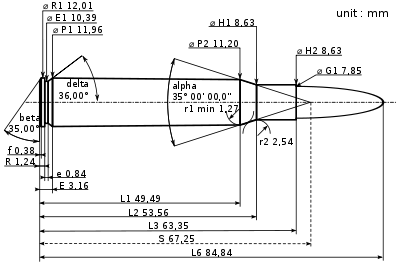Miller twist rule
Miller twist rule is a mathematical formula created by Don Miller to calculate the optimum rate of twist for a given bullet traveling through a rifled barrel.[1] Miller suggests that while Greenhill's formula works well there are better and more precise ways to calculate what the proper twist rate for a bullet should be that are not much more difficult to calculate.
Formula

The following formula is one recommended by Miller.[1]
where:
- m = bullet mass in grains
- s = gyroscopic stability factor (dimensionless)
- d = bullet diameter in inches
- l = bullet length in calibers
- t = twist in calibers per turn
Given those definitions we can expand:
where = twist in inches per turn, and
where = bullet length in inches.
Stability factor
Using Miller's formula we can also calculate the stability factor assuming we already know the twist. Simply solve for .
Twist in inches
It is possible to solve for twist in inches directly by solving for
Notes
Note that the constant 30 is Miller roughly approximating the velocity as 2800 ft/sec, standard temperature (59 degrees Fahrenheit), and pressure (750 mm Hg and 78% humidity) in the equation. Miller states that these values are taken from the Army Standard Metro but does note that his values are slightly off. He goes on to point out that the difference should be small enough that it can be ignored.
It should also be noted that the bullet density is missing from Miller's formula despite the fact that Miller himself states his formula expands upon Greenhill's. The bullet density in the equation above is implicit in through the moment of inertia approximation.
Finally, note that the denominator in Miller's equation is based upon the relative shape of a modern bullet. is roughly the formula for the shape of an American football.
Safe values
When computing this formula Miller states several safe values that can be used in place of some of the more difficult to determine variables. For example, he states that assuming a mach number of = 2.5 (or roughly 2800 ft/sec assuming standard conditions at sea level where 1 Mach is roughly 1116 ft/sec) is a safe value to use in regards to velocity. He also states that rough estimates that involve temperature should use = 2.0.
Example
If we take the Nosler Spitzer .30-06 Springfield round, which is similar to the one pictured above, we can easily fill in the variables and calculate the estimated twist rate.[2] Starting with the formula
We then fill in:
- m = 180 grains
- s = 2.0 (the safe value noted above)
- d = .308 inches
- l = 1.180" /.308" = 3.83 calibers
Which tells us we have 39.2511937 calibers per turn. We calculate using and see that
So our rifling should be roughly 12" per turn. The average twist of .30-06 caliber rifles is 10 inches per turn, so 12 inches per turn is fairly accurate. The discrepancy seen here also helps explain why certain bullets seem to work better in certain rifles when fired under similar conditions.
Comparison to Greenhill's formula
Greenhill's formula is actually much more complicated in full form. The rule of thumb that Greenhill devised based upon his formula is actually what is seen in most places, including Wikipedia. That rule was:
The actual formula was:[3]
where:
- S = gyroscopic stability
- s = spin rate in radians per second squared
- m = polar moment of inertia
- = pitching moment coefficient
- a = angle of attack
- t = transverse moment of inertia
- d = air density
- v = velocity
Thus, Miller, in essence, took Greenhill's rule of thumb and expanded it slightly while, at the same time, keeping the formula simple enough to calculate without advanced training in mathematics. To improve on Greenhill, Miller used mostly empirical data and some basic geometry.
Corrective equations
Miller, in his work, notes several corrective equations that can be used:
The velocity () correction for twist ():
The velocity () correction for stability factor ():
The altitude () correction under standard conditions: where is altitude in feet.
See also
References
- 1 2 Miller, Don. How Good Are Simple Rules For Estimating Rifling Twist, Precision Shooting - June 2009
- ↑ Nosler - Up Front, Accessed February 2012
- ↑ Mosdell, Matthew. The Greenhill Formula. http://www.mamut.net/MarkBrooks/newsdet35.htm (Accessed 2009 AUG 19)
External links
Calculators for stability and twist
- Bowman-Howell Twist Rate Calculator
- Miller Formula Calculator
- Drag/Twist Calculator based on Bob McCoy's "McGyro" algorithm